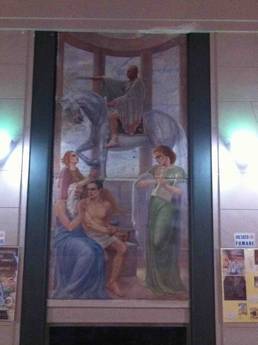A Mussolini Painting Stirs Controversy
Ouch. The painting was made by Aldo Castelli (1900-1965) in 1939, not exactly a great year for Italy and Europe, and the soldier portrayed is Mussolini, who aspired to restore the Roman Empire in the Mediterranean world. In the event, only four years after this triumphalist portrait was painted, Mussolini would instead be removed from power by King Victor Emmanuel III. and in the end Mussolini would be responsible for Italy's losing a war and the deaths of 291,376 Italian military. More Italians would die in concentration camps in Italy, Germany and Poland. Others would die in the two years of civil war that followed Mussolini's flight from Rome and the division of the country in two.
When local leftist politicians realized that Castelli's grandiose painting of Il Duce was hanging in a technical high school in Ascoli Piceno in the Marches on the Adriatic Coast, they not unreasonably raised a fuss. Students deomonstrated, and the organization of surviving partisan fighters ANPI was among those protesting along with the Partito Democratico (PD) and a group called Giovani Democratici (Young Dems). As a result, the painting was removed last week from the school wall, but not before the issue turned into a lively national debate.
"I thought of it as art," the school principal, Arturo Verna, has explained. "It is more anallegory than a portrait." At any rate he had the huge painting removed from the wall to avoid futile polemics, he went on to say in a letter to the PD provincial party organization, but "in reality the portrait of Mussolini has no ideological value" but rather an "historical and cultural significance" (finalità). CasaPound, the nationwide Fascistoid organization, protested that asking the painting's removal from the school wall is "Stalinist-style censorship from the ANPI [partisans' group] and the leftists", and that principal Verna is a coward who "lacks courage."
The artist's three children Fioretta, Paolo and Simonetta Castelli joined in the protests at the removal of the painting, which had been executed specifically to draw attention to the then novel institution of a technical high school, considered relatively democratic and pragmatic as opposed to the classical Italian liceo high school whose curriculum was and is based on studies of Latin, Greek and history. "You are exposing our father to an unworthy trial by the media," his children protested. (See the video >>>) In a letter they said, "We find ourselves in the embarrassing situation of having to protect the memory of a dignified artists whose personal history, unknown to most people, was based upon a value system very far from Fascist ideology. We do not believe that any member of our family can be included among those who have not yet taken history int account." Our father is being called a Fascist propagandist, they went on to say, and "this has caused us pain beyond description."
It is easy enough to agree with the angry who want to painting removed. They include not only the surviving partisan fighters who risked their lives to save Italy from Fascism, but also concentration camp survivors and their children, who have been phoning in to talk shows, writing emails and sending irate letters. But a few Italian intellectuals--and not only from the right and far right--are asking for a distinction to be made between Fascism as a totally discredited political, military and ideological concept, and the arts developed during the twenty years of Italian Fascism. This distinction is already made by scholars the world over, including the two American scholars whom I accompanied on a tour of Italian Fascist architecture. The question becomes whether or not a painting can have a purely aesthetic value if it includes a portrait of Il Duce. That is, is only architecture pure enough, and sufficiently independent of ideology, that it can be appreciated but painting cannot?
This is a problem not only for Italians. The great poet Ezra Pound was an anti-Semite and supporter of both Mussolini and Hitler. After living in Italy throughout the Fascist era, he was deported forcibly to the United States in 1945. Because he had notoriously made broadcasts in Italy in favor of the Fascist cause, he was confined in a steel cage for 25 days and then was to be tried for treason in the United States. To avoid this, his friends managed to have him declared insane and confined in St. Elizabeth's hospital for the criminally insane in Washington, DC. There he remained for more than a dozen years. Nevertheless he is considered one of the greatest of American poets, and his works are taught at U.S. universities. In his case a distinction is made between his writings and his belief system.
Can the same be asked for Castelli? Is it right that the painting be removed from its wall (as it has)? This writer has no answer, but it would be interesting to hear what you readers have to say on this. Is the portrait a legitimate part of history by now? Or still too dangerous to be put on view?




































i-Italy
Facebook
Google+
This work may not be reproduced, in whole or in part, without prior written permission.
Questo lavoro non può essere riprodotto, in tutto o in parte, senza permesso scritto.